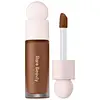Rare Beauty Liquid Touch Brightening Concealer Versus Makeup by Mario SurrealSkin Awakening Concealer
What's inside
What's inside
 Key Ingredients
Key Ingredients

 Benefits
Benefits

 Concerns
Concerns

 Ingredients Side-by-side
Ingredients Side-by-side

Water
Skin ConditioningDimethicone
EmollientHydrogenated Didecene
Skin ConditioningCetyl PEG/PPG-10/1 Dimethicone
EmulsifyingPropanediol
SolventGlycerin
HumectantAcrylates/Polytrimethylsiloxymethacrylate Copolymer
Skin ConditioningBoron Nitride
AbsorbentPolyglyceryl-4 Isostearate
EmulsifyingTrimethylsiloxysilicate
EmollientIsododecane
EmollientDisodium Stearoyl Glutamate
CleansingDisteardimonium Hectorite
StabilisingHydroxyacetophenone
AntioxidantOryza Sativa Bran Wax
Skin ConditioningSodium Chloride
MaskingDimethicone Crosspolymer
Emulsion StabilisingHelianthus Annuus Seed Oil
EmollientCaprylyl Glycol
Emollient1,2-Hexanediol
Skin ConditioningPhenyl Trimethicone
Skin ConditioningTocopheryl Acetate
AntioxidantAluminum Hydroxide
EmollientTrisodium Ethylenediamine Disuccinate
Dimethiconol
EmollientDecyl Glucoside
CleansingGardenia Florida Fruit Extract
Skin ConditioningHexylene Glycol
EmulsifyingNelumbo Nucifera Flower Extract
Skin ConditioningNymphaea Odorata Root Extract
RefreshingPhenoxyethanol
PreservativeCI 77891
Cosmetic ColorantIron Oxides
Water, Dimethicone, Hydrogenated Didecene, Cetyl PEG/PPG-10/1 Dimethicone, Propanediol, Glycerin, Acrylates/Polytrimethylsiloxymethacrylate Copolymer, Boron Nitride, Polyglyceryl-4 Isostearate, Trimethylsiloxysilicate, Isododecane, Disodium Stearoyl Glutamate, Disteardimonium Hectorite, Hydroxyacetophenone, Oryza Sativa Bran Wax, Sodium Chloride, Dimethicone Crosspolymer, Helianthus Annuus Seed Oil, Caprylyl Glycol, 1,2-Hexanediol, Phenyl Trimethicone, Tocopheryl Acetate, Aluminum Hydroxide, Trisodium Ethylenediamine Disuccinate, Dimethiconol, Decyl Glucoside, Gardenia Florida Fruit Extract, Hexylene Glycol, Nelumbo Nucifera Flower Extract, Nymphaea Odorata Root Extract, Phenoxyethanol, CI 77891, Iron Oxides
Water
Skin ConditioningPhenylisopropyl Dimethicone
Skin ConditioningIsododecane
EmollientTrimethylsiloxysilicate
EmollientButylene Glycol
HumectantDimethicone
EmollientCetyl PEG/PPG-10/1 Dimethicone
EmulsifyingCoconut Alkanes
EmollientPEG-10 Dimethicone
Skin ConditioningMethyl Methacrylate Crosspolymer
Sodium Chloride
MaskingSqualane
EmollientCaffeine
Skin ConditioningTocopherol
AntioxidantCoco-Caprylate/Caprate
EmollientDimethicone/Vinyl Dimethicone Crosspolymer
Skin ConditioningAluminum Dimyristate
Emulsion StabilisingDisodium Stearoyl Glutamate
CleansingDisteardimonium Hectorite
StabilisingSaccharide Isomerate
HumectantTriethoxycaprylylsilane
Pentaerythrityl Tetra-Di-T-Butyl Hydroxyhydrocinnamate
AntioxidantEthylhexylglycerin
Skin ConditioningPhenoxyethanol
PreservativeCI 77891
Cosmetic ColorantIron Oxides
CI 77163
Cosmetic ColorantWater, Phenylisopropyl Dimethicone, Isododecane, Trimethylsiloxysilicate, Butylene Glycol, Dimethicone, Cetyl PEG/PPG-10/1 Dimethicone, Coconut Alkanes, PEG-10 Dimethicone, Methyl Methacrylate Crosspolymer, Sodium Chloride, Squalane, Caffeine, Tocopherol, Coco-Caprylate/Caprate, Dimethicone/Vinyl Dimethicone Crosspolymer, Aluminum Dimyristate, Disodium Stearoyl Glutamate, Disteardimonium Hectorite, Saccharide Isomerate, Triethoxycaprylylsilane, Pentaerythrityl Tetra-Di-T-Butyl Hydroxyhydrocinnamate, Ethylhexylglycerin, Phenoxyethanol, CI 77891, Iron Oxides, CI 77163
 Reviews
Reviews

Ingredients Explained
These ingredients are found in both products.
Ingredients higher up in an ingredient list are typically present in a larger amount.
This ingredient is a high molecular weight silicone. It has emulsifying and skin conditioning properties.
Ci 77891 is a white pigment from Titanium dioxide. It is naturally found in minerals such as rutile and ilmenite.
It's main function is to add a white color to cosmetics. It can also be mixed with other colors to create different shades.
Ci 77891 is commonly found in sunscreens due to its ability to block UV rays.
Learn more about CI 77891Dimethicone is a type of synthetic silicone created from natural materials such as quartz.
What it does:
Dimethicone comes in different viscosities:
Depending on the viscosity, dimethicone has different properties.
Ingredients lists don't always show which type is used, so we recommend reaching out to the brand if you have questions about the viscosity.
This ingredient is unlikely to cause irritation because it does not get absorbed into skin. However, people with silicone allergies should be careful about using this ingredient.
Note: Dimethicone may contribute to pilling. This is because it is not oil or water soluble, so pilling may occur when layered with products. When mixed with heavy oils in a formula, the outcome is also quite greasy.
Learn more about DimethiconeDSG is used as a surfactant.
Surfactants are cleansing ingredients that help remove oil, dirt, and other impurities from the skin. They work by reducing surface tension between water and oils/dirt to allow them to be easily rinsed away.
Disteardimonium Hectorite comes from the clay mineral named hectorite. It is used to add thickness to a product.
It can also help stabilize a product by helping to disperse other ingredients.
Hectorite is a rare, white clay mineral.
Learn more about Disteardimonium HectoriteIsododecane is a fragrance, emollient, and solvent.
As an emollient, it helps your skin stay soft and hydrated. Emollients help trap moisture into your skin.
Isododecane's role as a solvent makes it a great texture enhancer. It spreads smoothly on skin and does not leave a sticky feeling behind. Isododecane also helps prevent color transfer in makeup products.
Isododecane is not absorbed into skin.
Learn more about IsododecanePhenoxyethanol is a preservative that has germicide, antimicrobial, and aromatic properties. Studies show that phenoxyethanol can prevent microbial growth. By itself, it has a scent that is similar to that of a rose.
It's often used in formulations along with Caprylyl Glycol to preserve the shelf life of products.
Chances are, you eat sodium chloride every day. Sodium Chloride is also known as table salt.
This ingredient has many purposes in skincare: thickener, emulsifier, and exfoliator.
You'll most likely find this ingredient in cleansers where it is used to create a gel-like texture. As an emulsifier, it also prevents ingredients from separating.
There is much debate on whether this ingredient is comedogenic. The short answer - comedogenic ratings don't tell the whole story. Learn more about comegodenic ratings here.
The concensus about this ingredient causing acne seems to be divided. Research is needed to understand if this ingredient does cause acne.
Scrubs may use salt as the primary exfoliating ingredient.
Learn more about Sodium ChlorideThis silicone is an emollient. Emollients create a thin film on the skin to prevent moisture from escaping.
It is not soluble in water and helps increase water-resistance in products.
According to a manufacturer, it can blend seamlessly with silicone oils, such as Cyclopentasiloxane.
Learn more about TrimethylsiloxysilicateWater. It's the most common cosmetic ingredient of all. You'll usually see it at the top of ingredient lists, meaning that it makes up the largest part of the product.
So why is it so popular? Water most often acts as a solvent - this means that it helps dissolve other ingredients into the formulation.
You'll also recognize water as that liquid we all need to stay alive. If you see this, drink a glass of water. Stay hydrated!
Learn more about WaterThis ingredient is a combination of red, black, and yellow iron oxide pigments. This combination of colors is usually found in foundation, because it results in a "skin" color.